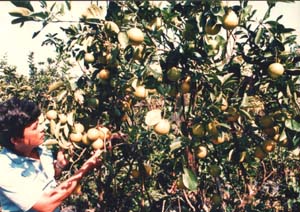|
|
|
University of the
Philippines BLISS Economic Fruit Garden |
|
(1980 to 1992) |
| |
|
Established in 1980, in cooperation with the Ministry of
Human Settlement as a showcase for green revolution, KKK and
Sariling Sikap program of the government, the garden was
situated at the BLISS Site of the University of the
Philippines in Diliman, Q.C. This is the first techno-demo
garden of Bernie Dizon in the city as a center for growing
grapes, durian, rambutans, lanzones, pummelos and other
exotic fruit trees. |
| |
|
|
| |
|
It is in this garden that Dizon has proven that
imported seedless and table grapes could grow and
bear fruits similar to those from where they
originated. It became a plant and a technology
exchange center where foreigners and 'balikbayans'
brought planting materials, scion, and literature
from the places they have been to.It is through
these materials that Dizon started to study the
growth habit of imported fruits. Later, he modified
the technology to suit local conditions and
propagated the imported varieties for local
distribution in other places of the country. |
 |
In
1993, UP developed the area into a commercial center thereby
uprooting all the trees Dizon painstakingly planted over the
years. UP then gave Dizon a substitute area at the
University Avenue within the UP BLISS. Big trees of lanzones,
pummelo, rambutan and lychee where balled and transferred to
the Malacañang Palace grounds.
|
Fruit trees from temperate
countries gown in RP |
|
Manila Bulletin, Friday, July 1, 1988
|
|
Noted agriculturist bares
fruit tree success |
|
Manila Bulletin, Sunday, April 15, 1990
|
|
Short course on fruit
growing set |
|
Manila Bulletin, Sunday, June 3, 1990
|
|
Multiple rootstock
technology can double your fruit output
|
|
Manila Bulletin, Sunday June 3, 1990
|
|
New farming technology
fails to reach end-user |
|
Manila Bulletin, Wednesday, November 20, 1991 |
At the substitute area where the UP BLISS economic
garden is now situated, the big Indian mango trees were
topworked with Imported Golden Queen, Chokanan Honey, Eating
Green, Guimaras carabao and Talaban mango. |
|
|
